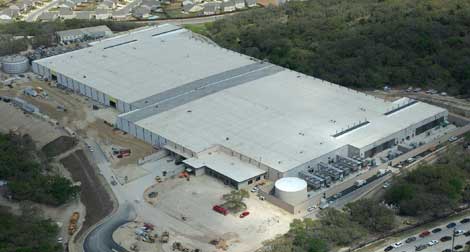As It Expands in San Antonio, Microsoft Sees Data Centers Transforming the Power GridAs It Expands in San Antonio, Microsoft Sees Data Centers Transforming the Power Grid
Microsoft wants to use its data centers to help transform the way electricity is delivered in the United States. That process will focus on San Antonio, TX, where the company has confirmed plans to build a new $250 million data center.
April 16, 2014

Microsoft wants to use its data centers to help transform the way electricity is delivered in the United States. That process will focus on San Antonio, where the company has confirmed plans to build a $250 million data center, along with a research project to develop new ways to use renewable energy to power Microsoft's cloud.
With its expansion, Microsoft will build a new 256,000 square foot data center next door to its existing facility in Westover Hills, a western suburb of San Antonio. When the new building is complete, Microsoft will have more than 700,000 square feet of data center space on its San Antonio campus. Data Center Knowledge reported the expansion plans last month, but Microsoft had no comment at the time.
Microsoft is also teaming with the University of Texas at San Antonio (UTSA) on a three-year research project to develop sustainable technologies to make data centers more energy efficient and economically viable. Microsoft director of energy strategy Brian Janous says the project is part of the company's vision for a new energy paradigm.
“This is one of our first major research partnerships to use data centers as a laboratory for next-generation energy technologies, but it certainly will not be our last,” Janous in blog post. "Distributed generation will be an important part of how we power our datacenters as we continue to pursue Microsoft’s energy strategy of transforming the energy supply chain."
An Ambitious Vision for Distributed Power
The research is part of Microsoft's focus on distributed power, part of a larger vision to break new ground in integrating cloud computing and distributed energy generation. The company hopes to place data centers alongside sources of renewable energy, creating "data plants" than operate with no connection to the utility power grid, using methane or other gases from landfills and water treatment plants. Microsoft is also researching the use of data center racks with on-board fuel cells, and even a distributed network of in-home data furnaces that use server exhaust to heat living spaces.
That big vision will start to take shape at UTSA. The multi-disciplinary research will focus on new distributed energy technology that reduces energy consumption and emissions, improves reliability and contributes to a sustainable energy future. Microsoft will contribute $1 million to UTSA's Sustainable Energy Reseach Institute (SERI) support the project.
"As part of this research, UTSA students will work hand-in-hand with Microsoft researchers to look into new 'fast-start generation' energy technologies such as micro-turbines to replace the diesel generators that are used during times of peak demand and grid outages," said Janous.
“Our objective is to bring together technology, economics and commercialization to create a smart intelligent energy system,” said C. Mauli Agrawal, vice president for research at UTSA. “We want to identify economically viable technologies that will reduce the environmental footprint of data centers.”
Greenpeace recently called out a bunch of companies, and the tactic seems to be working. Microsoft wasn’t on the “nice” list, despite making significant strides in the last year. So it is being both more transparent about the significant work it already has done, as well as increasing its efforts honorably.
Ongoing Focus on Data Center Sustainability
Microsoft is no slouch when it comes to renewables. Microsoft recently announced a power purchase agreement with a 110 megawatt wind farm in Texas. The company has also been working on data center innovations like in-rack power generation and biogas-powered datacenters. In November, the company began testing racks with built-in fuel cells, a move that would eliminate the need for expensive power distribution systems seen in traditional data centers – making them cheaper and greener. There’s also the waste powered data center in Cheyenne, Wyoming.
“These initiatives are bound together by our objective to transform the energy supply chain toward radically greater efficiency and reduced environmental impact,” Janous writes. The company isn’t solely focused on green sources of energy; it’s doing a lot of work within the data center.
It’s thinking about how it integrate power generation and energy storage into the design of a datacenter. The new agreement with UTSA will go a long way to achieving this somewhat less glamorous, but immensely important goal. Making data centers more efficient benefits the entire industry, and this research might help the type of company that doesn’t have access to 100 megawatts of wind power to grow more energy efficient at a smaller scale.
Why San Antonio?
Microsoft opened a data center in San Antonio in 2009. it was one of the first in the industry to employ technologies like using wastewater for cooling to reduce energy consumption, and there was the recent 110 megawatt purchase of wind energy there.
"Very few cities have embraced the clean energy economy like San Antonio and its mayor, Julian Castro," writes Janous. "In addition, The University of Texas at San Antonio (UTSA) has demonstrated its commitment to a more sustainable energy future by establishing The Texas Sustainable Energy Research Institute (SERI) under the leadership of Dr. Les Shephard, formerly of Sandia National Lab."
Data Center Knowledge Editor-in-Chief Rich Miller contributed to this story.
Read more about:
North AmericaAbout the Author
You May Also Like







